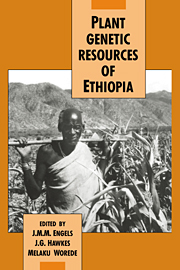Book contents
- Frontmatter
- Contents
- Contributors
- List of acronyms
- Preface
- Part I General introduction
- Part II The Ethiopian centre of diversity
- Part III Germplasm collection and conservation in Ethiopia
- Part IV Evaluation and utilization of Ethiopian genetic resources
- 18 Germplasm evaluation with special reference to the role of taxonomy in genebanks
- 19 Crop germplasm multiplication, characterization, evaluation and utilization at PGRC/E
- 20 Evaluation methods and utilization of germplasm of annual crop species
- 21 Evaluation and utilization of Ethiopian forage species
- 22 Improvement of indigenous durum wheat landraces in Ethiopia
- 23 Use of germplasm resources in breeding wheat for disease resistance
- 24 Indigenous barley germplasm in the Ethiopian breeding programme
- 25 The role of Ethiopian sorghum germplasm resources in the national breeding programme
- 26 Germplasm evaluation and breeding work on teff (Eragrostis tef) in Ethiopia
- 27 Pulse crops of Ethiopia: genetic resources and their utilization
- 28 Oil crop germplasm: a vital resource for the plant breeder
- 29 Significance of Ethiopian coffee genetic resources to coffee improvement
- 30 Use of Ethiopian germplasm in national and international programmes
- Index
25 - The role of Ethiopian sorghum germplasm resources in the national breeding programme
Published online by Cambridge University Press: 30 October 2009
- Frontmatter
- Contents
- Contributors
- List of acronyms
- Preface
- Part I General introduction
- Part II The Ethiopian centre of diversity
- Part III Germplasm collection and conservation in Ethiopia
- Part IV Evaluation and utilization of Ethiopian genetic resources
- 18 Germplasm evaluation with special reference to the role of taxonomy in genebanks
- 19 Crop germplasm multiplication, characterization, evaluation and utilization at PGRC/E
- 20 Evaluation methods and utilization of germplasm of annual crop species
- 21 Evaluation and utilization of Ethiopian forage species
- 22 Improvement of indigenous durum wheat landraces in Ethiopia
- 23 Use of germplasm resources in breeding wheat for disease resistance
- 24 Indigenous barley germplasm in the Ethiopian breeding programme
- 25 The role of Ethiopian sorghum germplasm resources in the national breeding programme
- 26 Germplasm evaluation and breeding work on teff (Eragrostis tef) in Ethiopia
- 27 Pulse crops of Ethiopia: genetic resources and their utilization
- 28 Oil crop germplasm: a vital resource for the plant breeder
- 29 Significance of Ethiopian coffee genetic resources to coffee improvement
- 30 Use of Ethiopian germplasm in national and international programmes
- Index
Summary
Introduction
Sorghum is one of the crop types for which Ethiopia has been credited as being a Vavilovian centre of origin or diversity (Harlan, 1969). In the different ecological zones of the country, germplasm resources representing the major and intermediate races of sorghum are found. In addition, the existence of wide variation in plant, grain, inflorescence and fruit characteristics in the Ethiopian sorghum germplasm is well documented (Gebrekidan, 1973; Gebrekidan & Kebede, 1977). Among the sorghum growing population in the rural areas, the importance of this crop is exemplified not only by its use as a staple food and for other purposes, but also in the folklore, songs and some of the local names by which the sorghum varieties are known.
As one of the leading traditional food cereals in Ethiopia, in terms of both total production and area, major research efforts have been directed towards the improvement and stabilization of sorghum yields. At a national level, sorghum improvement involves the manipulation of indigenous and introduced germplasm to develop adapted types for the various ecological zones. In crop improvement work the indigenous germplasm has been found invaluable (Gebrekidan, 1981).
Periodic sorghum germplasm collections made throughout the country have provided the sources of breeding material necessary for the sorghum improvement programme. In the high altitude areas the indigenous germplasm has often been the only adapted material suitable for use. From evaluations of germplasm collections, potential varieties have been identified.
- Type
- Chapter
- Information
- Plant Genetic Resources of Ethiopia , pp. 315 - 322Publisher: Cambridge University PressPrint publication year: 1991
- 13
- Cited by



